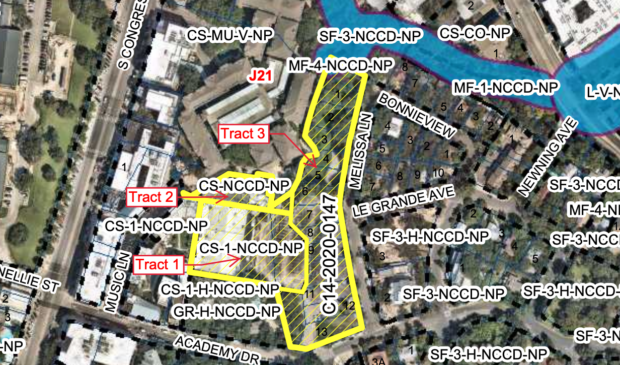Opera House gets green light from Council, but must compromise on size
Tuesday, June 14, 2022 by
Kali Bramble Months of negotiations with neighbors finally paid off for the team seeking to reopen the Austin Opera House, with City Council voting unanimously last Thursday to approve the necessary zoning changes.
The vote clears the path for applicant Chris Wallin to proceed with redevelopment, so long as the total area of the music venue does not exceed 10,000 square feet. The development also includes plans for a housing complex with 10 percent of units priced as affordable to those making below 80 percent of the median family income.
“We have gone from asking for no music venue to something the size of nearby clubs, to now accepting 10,000 square feet. We do still have numerous concerns about this increased size, safety to pedestrians, emergency access, and compatibility,” said Laura Toups on behalf of the Greater South River City Neighborhood Plan Contact Team. “It’s difficult for us to say we support this, but we can say we accept it, and we believe it serves the local music community and the developer while not really serving the surrounding neighborhood.”
The application to rezone 200 Academy Drive has been inching forward since last fall, when neighbors filed a valid petition against the proposed land use changes. Opponents argue that the 4.5 acres of parking lot and office space that was once home to the Opera House is far too close to the surrounding neighborhood to accommodate the pedestrian and car traffic generated by a venue of similar size.
Longtime Fairview Park resident Brian Beattie, who is a musician, said that “200 Academy has a proven history of being a dysfunctional location for a large club. It’s never worked for the neighborhood, the concertgoers, or the club’s financial success, and now it’s less connected to South Congress than it ever was. Every neighbor and neighboring business objects specifically and only to the large nightclub and the projected nightly, hourlong, slow-motion drunken gridlock … this is highly disruptive and dangerous in the middle of a neighborhood.”
The original Opera House opened in 1972 and hosted the likes of B.B. King, Tina Turner and Stevie Ray Vaughan before shutting its doors in 1992. With its 1,700-seat capacity, the venue endured similar friction with the surrounding neighborhood and was eventually forced to limit the frequency of concerts. Concern around such encroachments peaked with the establishment of a Neighborhood Conservation Combining District overlay in 1986, designed to protect Fairview Park from further redevelopment.
Now, these protections are beginning to unravel. Proponents of the new Opera House argue that Austin’s music scene, reeling from the aftermath of the Covid pandemic and skyrocketing property taxes, is in desperate need of a medium-sized venue. Originally angling for a complete restoration, owner Chris Wallin, partner Will Bridges and architect Richard Weiss have agreed to scale back the project to 10,000 square feet.
“Having venues of every size that give opportunities to local musicians is key to a great music ecosystem and was important to (my) early success,” said Zach Ernst of Black Joe Lewis and the Honeybears, who now works as talent buyer at the Paramount and Antone’s. “In my current world, booking multiple venues that host both local and touring bands, I can say firsthand that our calendars are generally full from September through May and we pass on a lot of shows by local bands because we don’t have the dates available.”
With the NCCD zoning overlay removed, the Opera House team is free to pursue their project within the 10,000-square-foot limit, though it remains to be seen what this will allow in capacity. Once redesigned, the project will return to the Planning Commission, where details like traffic infrastructure and a buffer zone of residential units are sure to be hot topics.
The Austin Monitor’s work is made possible by donations from the community. Though our reporting covers donors from time to time, we are careful to keep business and editorial efforts separate while maintaining transparency. A complete list of donors is available here, and our code of ethics is explained here.
You're a community leader
And we’re honored you look to us for serious, in-depth news. You know a strong community needs local and dedicated watchdog reporting. We’re here for you and that won’t change. Now will you take the powerful next step and support our nonprofit news organization?




